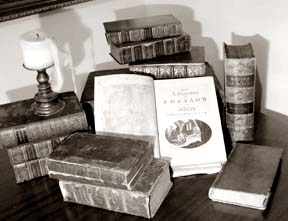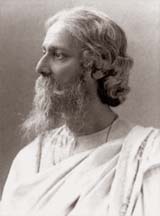|
observer |
|
|
|
|
|
OTHER LINKS |

|

|

|
Of literary bondagePart II In the 20th century, among the Indian individuals who exerted an
influence on Sri Lankan culture, the greatest was Rabindranath Tagore.
He is the only Indian to win the Nobel Prize for Literature, a hallmark
of world recognition, and the creator of the song in Bengali which was
adopted as the national anthem, although India had chosen Hindi as the
State language and Bengali is a language spoken by only 67 million in
India. In his Bengali essays, Tagore stresses that the Bengali
Tagore was not chauvinistic. He emphasized that an India, bereft of Western contact, would have been wanting in an essential element in her quest for fulfilment. Like Jawaharlal Nehru in The Discovery of India, Tagore believed that the greatest blessing of British rule was that it enabled the heterogeneous country that was India to rise in one voice, the Indian voice. Tagore expresses his view of freedom: Where the mind is free,/and the head is held high,/where knowledge is free;/Where the world has not been broken up/into fragments by narrow domestic walls Tagore seems to me the quintessential Indian.As commonly in ex-colonies, the presence of the colonial 'masters' had a suffocating effect on the creative energies of the local inhabitants in Sri Lanka and the emergence of Sri Lankan English literature flows from the growth of nationalist currents. This growth was stimulated by the freedom struggle in India and by certain remarkable Indians who were active in that period. In the 1930s and early 1940s, the Kandy Lake poets were inspired by Indian poets such as Tagore and Sarojini Naidu. Characteristic of this kind of poetry are these lines of Sunetha Wickremasinghe: See the nights are dewy, sister; see the winds are friends to me Lone the moonlight breathes a whisper o'er the dreaming Mahaveli You may call it madness, sister, but to stay me, O 'tis vain, For the winds of freedom beckon, hark they call again, again. R.K. Narayan's success in the West is likely to have stimulated Jinadasa Vijayatunga. D.F. Karaka was a household word in Sri Lanka at that time; his fiction and non-fiction would have acted as a stimulus to local writing. S.W.R.D. Bandaranaike attended a performance of Tagore's Saapmochan which Tagore himself staged in Colombo during a visit to Sri Lanka in 1934, and Bandaranaike wrote in his review (which included a quotation from Sarojini Naidu's poetry) India has as good a reason to be proud of Tagore as of Gandhi; for he has made an original contribution to art which can stand the test of comparison with anything of the kind the West has evolved. Ediriwira Sarachchandra (1914-1996), a remarkable bilingual, became the pre-eminent man of letters in Sinhala as well as the leading novelist in English. Some of his formative influences were Indian. When he was a schoolboy at St. Thomas's College in the 1920s and early 1930s, he came into contact with Tagore, a collection of whose short stories was a prescribed text at the College. The mysticism of Gitanjali made a deep impact on Sarachchandra. He read of Tagore, and of Santiniketan, the institution Tagore had founded in Bengal, where the life led by the teachers and students accorded with Tagore's credo of high thinking and plain living and seemed to Sarachchandra ideal. When Sarachchandra was a student at University College, Colombo, he saw at the Regal Theatre a performance of the same Tagore dance drama which Bandaranaike did, and recorded his experience: During the ballet we saw the great poet Rabinranath Tagore seated on stage, keeping time with his foot to the rhythm of the music, and savouring the pleasure given by his creation. In his long robe and black headgear, with white hair flowing on either side of his face and a beard that covered his chest, he was an impressive individual with an aura of majesty about him. To see him in the flesh was happiness of a sort I had never hoped". Bengali music and danceShortly afterwards, Sarachchandra witnessed Uday Shankar dance, with his troupe, at the same theatre. Sarachchandra became enchanted by Bengali music and dance, which he identified as a part of his cultural heritage, and desired to go to Santiniketan to study it. He succeeded in doing so. When he returned to Ceylon from India in 1940, he was a transformed man. In the last 20 years, translators into Sinhala have shown a remarkable interest in Indian literature, both the literature in English and the literature in the vernacular languages. Bobby Boteju believes that one should know the literatures of neighbouring countries before one ventures further afield. He has devoted himself to translating Indian short stories and translated over one thousand of these. He was the first to introduce R.K. Narayan to the Sinhala reading public by translating Malgudi Days in 1991. He has translated stories by C. Rajagopalachari, the first Governor General of India after Independence, and stories by Asokamitran, originally written in Tamil; stories by Premchand, originally written in Hindi; stories by Takazi Sivasankar Pillai, originally written in Malayalam; stories by Tagore, originally written in Bengali; and stories by numerous other writers. Kusum Dissanayake has been motivated to translate Indian literature into Sinhala by the similarities between the Indian environment/culture and ours which lead to its relevance to the concerns of our reading public. All these translations into Sinhala from the Indian vernacular languages have been done via English renderings, but Chinta Lakshmi Sinharachchi has translated Indian vernacular literatures directly from the original languages, Bengali, Hindi and Urdu, and consequently she is able to capture subtle nuances of language and feeling. She has translated Tagore?s Gora from the Bengali, Premchand's Godani from the Hindi, Chattopadyaya's Aranayak from the Bengali, the original texts of Satyajith Ray's trilogy, Apparajitho, Pather Panchali and Apu Sansar. Among the Indian writers in English, R.K. Narayan has been a favourite among translators into Sinhala: W.A. Abeysinghe has translated Swami and Friends; Kulasena Fonseka The Painter of Signs; Milroy Dharmaratne The Dark Room. All the translations from Indian literature have been well received by the Sinhala reading public, probably, because of their relevance. Mr. Sarath Wijesuriya, a publisher, has informed me that he has published translations into Sinhala of works by such writers as Simone de Beauvoir and Italo Calvino, but that these translations from Western writers sold much less and were less influential than the translations from Indian writers. Most of the translations from Indian writers are more or less recent, and it is perhaps too early to think in terms of their impact on creative writing in Sinhala. But there are already signs of influence. Chinta Lakshmi Sinharachchi's translations are of works that reveal a deep understanding of women and a sensitivity to female harassment. These seem to have influenced contemporary female Sinhala writers such as Anula Wijeratne Menike, Manel Karunatilake and Sunethra Rajakarunanayake. Arguably, female writers are in the forefront of contemporary Sinhala literature. R.K. Narayan's and Mulk Raj Anand's concern for the downtrodden seems to have had an impact on works such as Kulasena Fonseka's Palama Yata [Under the Bridge]. Enthusiastic responseThe interaction of India and Sri Lanka in literature has occurred in Sri Lanka, but the interaction of Sri Lanka and India in India is little. Sri Lanka enters the Ramayana. Rev. Buddhagosha took back to India the Buddhist scriptures he translated into Pali in Sri Lanka. In recent times, Penguin Books India published my anthologies New Writing in Sri Lanka (1992) and Modern Sri Lankan Stories (1996), and these elicited an enthusiastic response from Indian reviewers. Penguin India also published a few novels and stories by individual Sri Lankan writers. But there do not seem to be signs of these books having had an impact on the literatures of India, though these would have increased the Indian understanding of Sri Lanka among readers in English. But a non-fictional book, Susantha Goonatilake's Crippled Minds has been translated into an Indian vernacular, the State language, Hindi; enjoys a far greater readership and is having an impact on Indian thinking. One hopes that more Sri Lankan books will be published in India, not only in English but in the vernacular languages, especially our literature in Sinhala. Ideally, from a Sri Lankan point of view, the traffic should not be one way. Yet the fact remains that, in the sphere of culture, cross-fertilization, Sri Lanka has needed/needs India but India can do without Sri Lanka, given India's much larger base in civilization and far greater pool of talent. |

 word for
literature, sahitya, derives from sahit and etymologically means
together or intimacy. His often sung lyric was: Nowhere is there sorrow,
or death or separation./However far with all my soul, I speed unto thy
boundless world;/But, the moment I turn my gaze from thee unto
myself,/Death becomes deathly, and sorrow, sorrow's deep well.
word for
literature, sahitya, derives from sahit and etymologically means
together or intimacy. His often sung lyric was: Nowhere is there sorrow,
or death or separation./However far with all my soul, I speed unto thy
boundless world;/But, the moment I turn my gaze from thee unto
myself,/Death becomes deathly, and sorrow, sorrow's deep well. 







